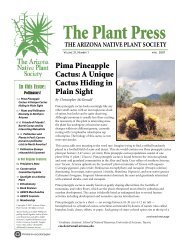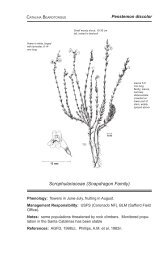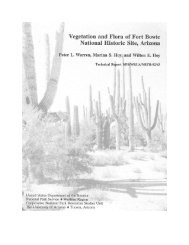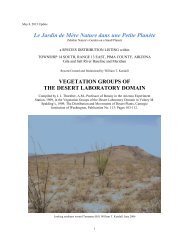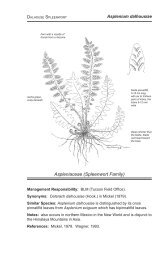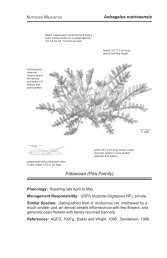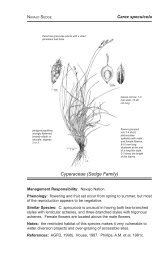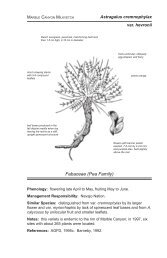T14S.R13E Pima County.AZ 050813 - Arizona Native Plant Society
T14S.R13E Pima County.AZ 050813 - Arizona Native Plant Society
T14S.R13E Pima County.AZ 050813 - Arizona Native Plant Society
You also want an ePaper? Increase the reach of your titles
YUMPU automatically turns print PDFs into web optimized ePapers that Google loves.
Purplehead (a name also applied to the species); Typical Beautiful Blue Dicks; Typical Beautiful Blue-dicks; Typical BeautifulBluedicks; Typical Blue-dicks California-hyacinth; Typical Capitate Blue Dicks; Typical Capitate Blue-dicks (a name alsoapplied to the genus Dichelostemma); Typical Capitate Bluedicks; Typical Chester Lily; Typical Common Blue Dick; TypicalCommon Blue Dicks; Typical Common Blue-dick; Typical Common Blue-dicks; Typical Common Bluedicks; Typical CommonBrodiaea; Typical Common Saitas; Typical Covenna; Typical Desert Hyacinth Blue Dicks; Typical Desert Hyacinth Blue-dicks;Typical Desert Hyacinth Bluedicks; Typical Hyacinth Blue Dicks; Typical Hyacinth Blue-dicks; Typical Hyacinth Bluedicks;Typical Papago Lily; Typical Vernal Pool Bluedicks; Typical Wild Hyacinth Blue Dicks; Typical Wild Hyacinth Blue-dicks;Typical Wild Hyacinth Bluedicks (a name also applied to the species); Wild Hyacinth (a name also applied to the species andother species). DESCRIPTION: Terrestrial perennial forb/herb (4 to 40 inches in height); the leaves are dark green; the flowersmay be light blue, blue, dark blue, blue-purple, bluish-purple, lavender, dark lavender, pink, pinkish-purple, pale purple, purple,dark purple, purple-blue, violet or white; flowering generally takes place between early February and early June (additionalrecords: two for late June, one for mid-July, one for late August; flowering beginning as early as December and ending as late asJuly has been reported). HABITAT: Within the range of this species it has been reported from mountains; mountainsides; rockymesas; gravelly plateaus; along canyon rims; canyons; canyon walls; gravelly-sandy canyon bottoms; talus; sandy pockets of soilon rocky banks; bluffs; rocky ridges; ridgetops; meadows; rocky foothills; cobbly-sandy-loamy hills; rocky hilltops; bouldery,rocky, rocky-sandy, gravelly-clayey-loamy and sandy hillsides; bouldery, rocky, cobbly-sandy-loamy, gravelly, gravelly-sandyclayey-loamy,sandy and sandy-loamy slopes; bajadas; bouldery and rocky outcrops; amongst boulders and rocks; rocky banks;rocky, rocky-clayey-loamy, gravelly, sandy and sandy-loamy flats; valley floors; in gravelly roadbeds; bouldery roadcuts; alongrocky, rocky-clayey, stony-clayey and sandy roadsides; draws; gravelly streambeds; creekbeds; along and in stony-gravelly andsandy washes; depressions; (sandy) banks of rivers; sandy benches; sandy terraces; riparian areas; waste places, and disturbedareas growing in dry (one record for a wet sandy wash) desert pavement; bouldery, rocky, rocky-sandy, stony-gravelly, gravelly,gravelly-sandy and sandy ground; rocky-clayey loam, cobbly-sandy loam, gravelly-sandy-clayey loam, gravelly-clayey loam,sandy loam and loam ground; rocky clay, stony clay and clay ground, and silty ground, occurring from sea level to 9,800 feet inelevation in the forest, woodland, scrub, grassland and desertscrub ecological formations. NOTES: This plant may be anattractive component of a restored native habitat. Dichelostemma capitatum subsp. capitatum is native to southwest-central andsouthern North America. *5, 6, 16 (recorded as Dichelostemma pulchellum (Salisb.) Heller), 28 (recorded as Dichelostemmapulchellum, color photograph 680), 43 (081609), 44 (100311), 46 (recorded as Dichelostemma pulchellum (Salisb.) Heller, Page182), 63 (081609 - color presentation), 85 (100311 - color presentation), 89 (reported as being a perennial herb located onTumamoc Hill, recorded as Brodiea capitata Benth.), 115 (color presentation of the species), 124 (100311 - no record of genus,species), 140 (Page 306 - recorded as Dichelostemma pulchellum (Salisbury) Heller, placed in the Themidaceae)*Dichelostemma capitatum (G. Bentham) A. Wood subsp. pauciflorum (J. Torrey) G. Keator: BluedicksSYNONYMY: Brodiaea pulchella (R.A. Salisbury) E.L. Greene var. pauciflora (J. Torrey) C.V. Morton,Dichelostemma pulchellum (R.A. Salisbury) A.A. Heller var. pauciflorum (J. Torrey) R.F. Hoover. COMMON NAMES: BlueDicks (a name also applied to the species and genus Dichelostemma); Bluedicks (a name also applied to the species and genusDichelostemma); Brodiaea (a name also applied to the species); Covena (a name also applied to the species); Covenna (a namealso applied to the species); Coveria (a name also applied to the species); Crow Poison (a name also applied to the species andother species); Desert Blue-dicks (a name also applied to the species); Desert Hyacinth (a name also applied to the species andother species); Few Flower Blue Dicks; Few Flowered Blue Dicks; Few-flower Blue Dicks; Few-flowered Blue Dicks; FewflowerBlue-dicks; Few-flowered Blue-dicks; Few-flowered Bluedicks; Few-flowered Covena; Fewflowered Blue Dicks; Fool’sOnion (a name also applied to other species); Fool’s-onion (a name also applied to other species); Grass Nuts (a name alsoapplied to the species and other species); Grass-nuts (a name also applied to the species and other species); Hahd (a name alsoapplied to the species, <strong>Pima</strong>); Indian Hyacinth (not recommended, a name also applied to the species); Papago Lily (a name alsoapplied to the species); Purplehead (a name also applied to the species); Wild Hyacinth (a name also applied to the species andother species). DESCRIPTION: Terrestrial perennial forb/herb (4 to 30 inches in height); the leaves are dark green; the flowersmay be pale blue, blue, blue-lavender-purple, blue-purple, bluish-lavender, lavender, pink, pink-purple, purple or white;flowering generally takes place between late January and mid-June (additional records: one record for early January, one recordfor mid-July, one record for mid-September and one record for early November). HABITAT: Within the range of this species ithas been reported from rocky mountains; rocky mountainsides; gravelly and sandy mesas; plateaus; along rocky canyons; rockycanyon bottoms; buttes; gravelly ridges; rocky ridgetops; foothills; rocky hills; sandy hilltops; rocky, gravelly hillsides; rocky andsandy slopes; rocky-sandy alluvial fans; bajadas; rocky outcrops; amongst rocks; prairies; plains; gravelly, gravelly-loamy andsandy flats; basins; sandy valley floors; along roadsides; rocky arroyos; along draws; gulches; ravines; along streams; siltycreekbeds; rivers; riverbeds; along and in rocky and sandy washes; sandy beaches; gravelly terraces; sandy lowlands; ditches;around stock tanks; riparian areas, and disturbed areas growing in dry desert pavement; rocky, rocky-sandy, cindery, gravelly andsandy ground; cobbly-silty loam, gravelly loam and sandy loam ground; rocky clay, stony clay and clay ground, and silty ground,occurring from 900 to 8,600 feet in elevation in the forest, woodland, scrub, grassland, desertscrub and wetland ecologicalformations. NOTES: This plant may be an attractive component of a restored native habitat, the flowers are reported to befragrant. Dichelostemma capitatum subsp. pauciflorum is native to southwest-central and southern North America. *5, 6, 15, 28(recorded as Dichelostemma pulchellum, color photograph 680), 43 (081609), 44 (100311), 46 (recorded as Dichelostemmapulchellum (Salisb.) Heller var. pauciflorum (Torr.) Hoover, Page 182), 58, 63 (081609 - color presentation), 77 (recorded asDichelostemma pulchellum (Salisb.) Heller, color photographs #56 and #103), 85 (100411 - color presentation), 86 (note,26



